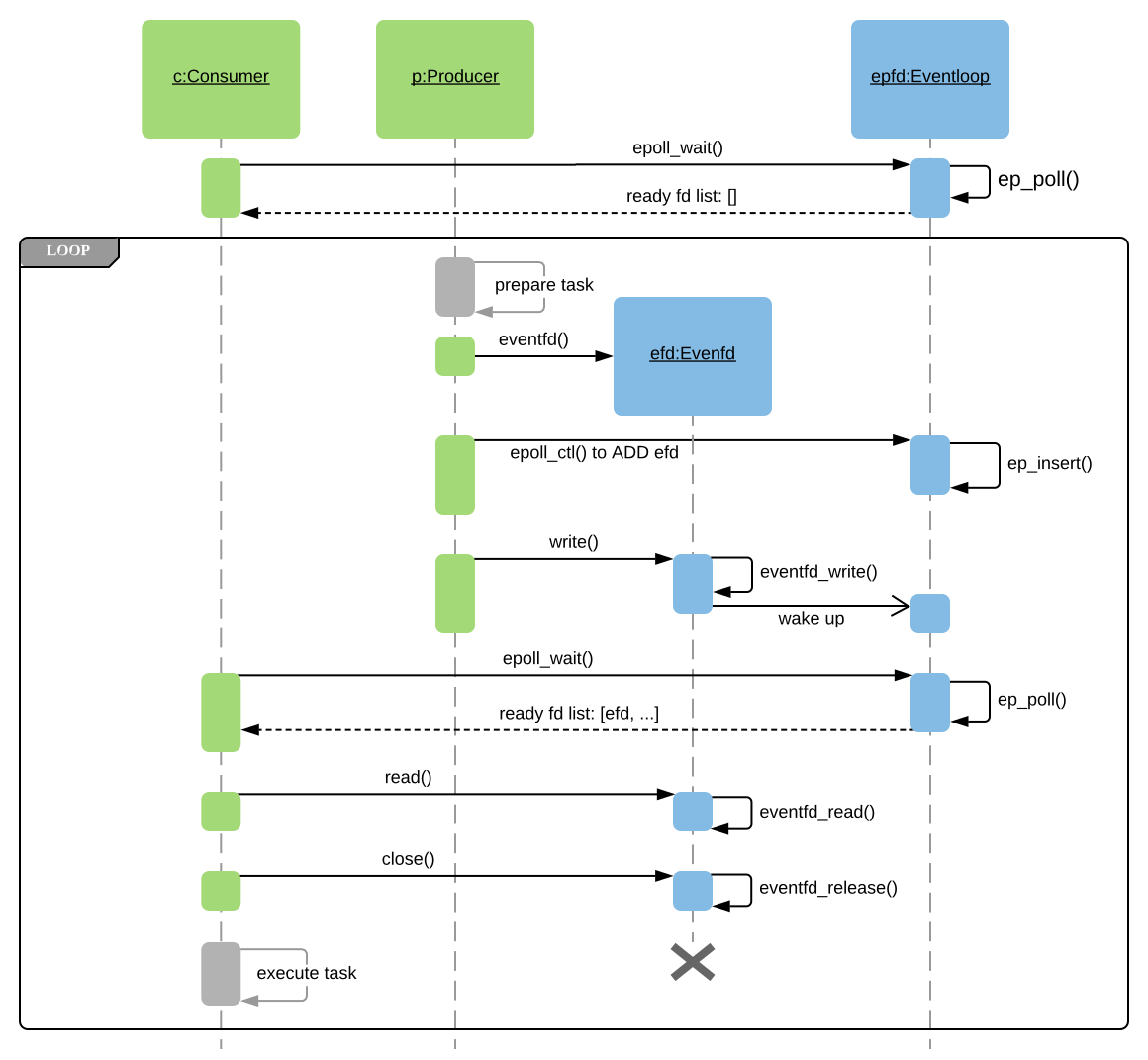Handler Looper MQ 的几个问题

前言
Handler、Looper、MessageQueue 是老生常谈的话题了,你可能会觉得没什么好讲的啊,网上文章也一堆。
这里我有几个问题问一下,如果你都很清晰,那就完全不需要看此文。
1.多个 Handler 可以往同一个 MQ 里发消息么?如果可以,多个 Handler 都会处理对应的消息么?为什么?
2.Looper 会
单纯的因为取不到消息而导致死循环退出么?
3.
Looper 是死循环,为什么主线程没有卡死(这个看 https://www.zhihu.com/question/34652589)
4.是接着问题2的一系列问题。看过 MQ.next() 方法么?看过 nativePollOnce() 的代码?如果看过会发现调用流程是: nativePollOnce() -> pollOnce() -> pollInner()。但是 pollOnce() 是个死循环,nativePollOnce() 怎么跳出去的?
5.Java 层和 Native 层的 MQ、Looper 有什么关系吗?有什么优先级么?
6.如果主线程处于休眠状态,点击屏幕的时候又是怎么被唤醒的?点击事件是通过什么机制传递过来的?(IMS)
问题解析
Question 1
Handler 有众多传递事件的方法
诸如: sendMessage()、post() 等等
不过这些方法最终都汇聚于一个方法 enqueueMessage()
private boolean enqueueMessage(MessageQueue queue, Message msg, long uptimeMillis) {
// this 就是 Handler 对象
msg.target = this;
if (mAsynchronous) {
msg.setAsynchronous(true);
}
return queue.enqueueMessage(msg, uptimeMillis);
}
Handler 的构造函数也有多个
public Handler(Looper looper, Callback callback, boolean async) {
mLooper = looper;
mQueue = looper.mQueue;
mCallback = callback;
mAsynchronous = async;
}
public Handler(Callback callback, boolean async) {
// 省略
mLooper = Looper.myLooper();
if (mLooper == null) {
throw new RuntimeException(
"Can't create handler inside thread " + Thread.currentThread()
+ " that has not called Looper.prepare()");
}
mQueue = mLooper.mQueue;
mCallback = callback;
mAsynchronous = async;
}
通过以上可知,Handler 初始化要么当前线程已经存在 Looper,要么自己绑定一个 Looper。
主线程的 Looper 在 AcitivityThread.main 方法(App 进程创建的时候)已经通过 Looper.prepareMainLooper() 创建完成了。
那么,当然是可以在主线程创建多个 Handler 绑定到同一个 Looper(MQ 与 Looper 相对应)的,这些 Handler.enqueueMessage() 方法均是往同一个 Looper 所对应的同一个 MQ 里发送消息。
但是可以看到 enqueueMessage() 时,每一个 Message 对象的 target 属性都被设置为了发送此消息的 Handler(见上方源码),所以谁发的 Message 谁自己处理,这当然也是合情合理的。
答:
多个 Handler 可以往同一个 MQ 发消息,但是谁发的消息谁处理,因为 Message 保留了 Handler 对象的引用。(当然 Looper 其实也是通过取得 Message 之后,用 Message.target 回调到 Handler.handleMessage() 的)
Question 2
Looper.loop() 众所周知是一个死循环,但是细看代码你会发现一些问题
loop() 方法部分源码如下:
for (;;) {
Message msg = queue.next(); // might block
if (msg == null) {
// No message indicates that the message queue is quitting.
return;
}
// 省略
}
省略了很多代码,只看这个 queue.next() 方法,发现只要 msg == null 就 return 了,不就退出了?但是不会出现这种情况,后面说原因。
Looper.quit()
先看看 quit() 方法,其实它调用的是 MQ.quit() 方法,可以传一个 safe 参数判断是否管理剩余的消息。具体的代码如下:
void quit(boolean safe) {
if (!mQuitAllowed) {
throw new IllegalStateException("Main thread not allowed to quit.");
}
synchronized (this) {
if (mQuitting) {
return;
}
mQuitting = true;
if (safe) {
removeAllFutureMessagesLocked();
} else {
removeAllMessagesLocked();
}
// We can assume mPtr != 0 because mQuitting was previously false.
nativeWake(mPtr);
}
}
通过源码会发现 mQuitAllowed 这个值,如果是 false, 就是不让 Looper 退出直接抛出异常,且这个参数是 Looper 初始化时传入的。
所以,其实即使我们想要 主动 调用 quit() 方法让 Looper 退出,也要看创建 Looper 时的 mQuitAllowed 参数。MainLooper 此处就是 false,所以没法调 quit 方法。
queue.next() 为什么不会是 null
先看代码:
Message next() {
final long ptr = mPtr;
if (ptr == 0) {
return null;
}
int pendingIdleHandlerCount = -1; // -1 only during first iteration
int nextPollTimeoutMillis = 0;
for (;;) {
if (nextPollTimeoutMillis != 0) {
Binder.flushPendingCommands();
}
nativePollOnce(ptr, nextPollTimeoutMillis);
}
// 省略
}
mPtr 如果为 0 自然返回 null,但是正常情况下这个不可能的,因为 mPtr 是 MQ 初始化时调用的 nativeInit 返回的一个 NativeMQ 指针。
后面的代码均包含在了 for 死循环中,且只会 return 实体 message,而 nativePollOnce 最终会调用到 epoll_wait() 而使得线程被挂起休眠,具体查看问题3。
所以除非有什么系统故障,否则 Looper 要么因为取不到消息而休眠,要么就返回一个非空消息。
答:
除非有系统故障,否则不会单纯的因为取不到消息而导致死循环退出。这也合情合理,主 Looper 退出了,后续的事件又如何处理呢?
Question 3
这个查看知乎链接即可。
https://www.zhihu.com/question/34652589)
首先是因为 epoll_wait() 的情况下,主线程只是被挂起,并不耗费 CPU。其次,如果有事件到来,也会通过 epoll 机制唤醒主线程。再其次,binder 线程池的存在使得可以从其所在线程通过 Handler 发送消息到主线程或者其他方式,最终能够唤醒主线程。
如何唤醒的呢?
首先需要一个 文件描述符(fd,Linux 一切皆文件) 且支持 poll 操作。之后通过 epoll_ctl() 注册,epoll_wait() 等待事件到来。
事件如何来?
往 fd 里写入数据等等,根据 epoll_ctl 注册的消息类型会进行相应的唤醒。
Looper 处理 Java 层 enqueueMessage 唤醒时,老版本使用了 pipe,新版本使用了 eventfd
Question 4 & 5
MessageQueue.next() 方法 Question 2 已经看过了。
之后的 native 调用过程是 nativePollOnce() -> pollOnce() -> pollInner()
伪代码大概如下(源码太长自己去看):
// pollOnce
for (;;) {
while (mResponseIndex < mResponses.size()) {
const Response& response = mResponses.itemAt(mResponseIndex++);
int ident = response.request.ident;
if (ident >= 0) {
// 省略
return ident;
}
}
if (result != 0) {
// 省略
return result;
}
result = pollInner(timeoutMillis);
}
// pollInner
int Looper::pollInner(int timeoutMillis) {
// 省略
struct epoll_event eventItems[EPOLL_MAX_EVENTS];
int eventCount = epoll_wait(mEpollFd.get(), eventItems, EPOLL_MAX_EVENTS, timeoutMillis);
for (int i = 0; i < eventCount; i++) {
int fd = eventItems[i].data.fd;
// 省略
pushResponse(events, mRequests.valueAt(requestIndex));
}
// 省略
for (size_t i = 0; i < mResponses.size(); i++) {
Response& response = mResponses.editItemAt(i);
if (response.request.ident == POLL_CALLBACK) {
// 省略
int callbackResult = response.request.callback->handleEvent(fd, events, data);
if (callbackResult == 0) {
removeFd(fd, response.request.seq);
}
// 省略
}
}
return result;
}
可以看到,一进入 pollOnce() 就是一个死循环。但是,是有几个 return 条件的,result 的值通过 pollInner() 返回,pollInner() 才真正调用了 epoll_wait() 使得线程挂起。
当有事件来时,我们会首先读取监听的 event 事件(pushResponse),之后在循环所有的事件进行处理,而且只要有对应的事件发生,result 的返回值总不会是 0。
result 有几种取值
enum {
/**
* Result from Looper_pollOnce() and Looper_pollAll():
* The poll was awoken using wake() before the timeout expired
* and no callbacks were executed and no other file descriptors were ready.
*/
POLL_WAKE = -1,
/**
* Result from Looper_pollOnce() and Looper_pollAll():
* One or more callbacks were executed.
*/
POLL_CALLBACK = -2,
/**
* Result from Looper_pollOnce() and Looper_pollAll():
* The timeout expired.
*/
POLL_TIMEOUT = -3,
/**
* Result from Looper_pollOnce() and Looper_pollAll():
* An error occurred.
*/
POLL_ERROR = -4,
};
所以,pollOnce() 的死循环 不会退不出去,也不会因此一直卡在 nativePollOnce() 方法中。当 pollOnce() 和 nativePollOnce() 返回以后,Java 层的 MQ.next() 方法继续执行,才取到了 MQ.java 中的 Message,进行后续的调用。
答:
pollOnce() 不会一直跳不出,只要有事件到来,都能跳出死循环。同时,Java 层和 Native 层的同样的一套机制可以互相引用,但是,是完全的两套东西,包括 MQ 也是各自管理各自的。但是 Native 的优先级更高,因为处理完了 Native 的事件以后,才开始处理 Java 层的事件。
Question 6
看过 InputManagerService 都知道,输入事件的传递是依赖 socket 通信的。那么它又是怎么唤醒主线程的呢?
在 Native 层的 Looper 中有 addFd() 方法,socket 同样是一个 fd,Looper.addFd() 通过 epoll_ctl 注册 socket 监听。
当有输入事件需要传递时,只需要往 socket 中写入数据,就可以唤醒主线程。
依然是会回到 pollInner() 相关的代码
response.request.callback->handleEvent(fd, events, data)
这里其实已经开始到了主线程相关的事件分发部分,并且通过 Native 层直接调用 Java 层代码的方式调了回去,直到 ViewRootImpl.deliverInputEvent()
详见: http://gityuan.com/2016/12/31/input-ipc/
答:同样是通过 epoll 机制唤醒
Worker Pool
其实无论是 Android 还是其他的事件驱动的模型,原理都相似,下文就是介绍一个 Worker Pool 的设计。
其实,我们的主线程可以看做是一个消费者,不断消费各种事件,而各种其他的线程(Android 中,如 InputManagerService 等等系统服务)都可以看做是生产者,不断的产生事件通知,交给主线程处理,从而让整个程序得以运转。
https://www.yangyang.cloud/blog/2018/11/09/worker-pool-with-eventfd/
总结
其实了解这些对于实际开发作用并不大,而且整个过程依然有很多细节没有深究。
但是,对于原理和模型的了解是十分必要的,了解了这些才能举一反三。
引用
https://www.yangyang.cloud/blog/2018/11/09/worker-pool-with-eventfd/